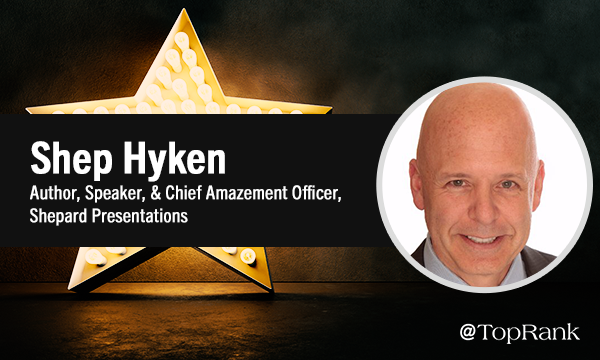
Meet Shep Hyken
Eliminating the Customer Experience Enemy
Your goal is to deliver the right information, at the right time, to the right person, on the right platform. This is the essence of convenience. You want to make it easy on your audience to get the information they need and to make a decision—and you want to enhance the journey and create a better experience for all. How do you do this? By reducing friction. Why? Because where friction exists, frustration exists—and frustrated buyers and customers will seek out the path of least resistance. “Reducing friction is perhaps the No. 1 opportunity for marketers,” Shep states. “It’s simple. If you don’t know your friction points, you can’t improve the customer experience and build customer loyalty.” Where should you start? As Shep suggests: “Map and study your customer journey, and ask yourself: What are my top customer touch points? Where is there friction? And how can I reduce that friction?” [bctt tweet="Where friction exists, frustration exists—and frustrated buyers and customers will seek out the path of least resistance. #Convenience #DigitalMarketing" username="toprank"]Strengthening Existing Customer Relationships & Attracting Prospects
The customer journey is anything but linear. We know prospective buyers and existing customers are increasingly self-directed in their quest for answers. Many turn to the internet-at-large and social media to research solutions, engage with brands, inform their decisions, and troubleshoot issues. Marketers have the opportunity to create on-demand content that not only aids existing customers, but also engages prospects. For Shep, this falls under the convenience category of self-service. [bctt tweet="#Marketers have the opportunity to create on-demand #content that not only aids existing customers, but also engages prospects." username="toprank"] “Salesforce is a great example of this principle in action,” he says. “They offer great explainer and how-to content online, which gives their existing customers answers at their fingertips. If customers have a question or issue, they don’t have to call support." Here's an example of one of Salesforce's How-To videos, one of many featured on their YouTube channel: “What makes this a fantastic marketing piece is that anyone who happens to be considering their products can see this great content, allowing them to learn more about how a product works and the level of support offered,” he says. But what about those who stop the search early and just pick up the phone? Shep says self-service content still plays a pivotal role. “This content is a great supplement for live support,” he says. “Your team member can answer questions live, but also offer more convenient, digital solutions customers or prospects can walk away with.”Defining Your Own Brand of Convenience
Here’s an important thing to remember, marketers: Convenience is objective. As Shep points out, what’s considered convenient for one business may simply be unacceptable for another—even within the same industry. That’s why it’s important to define your own brand of convenience—and not fall victim to what Shep calls “We Can Do It Too” Syndrome. “Marketers need to stop placing so much emphasis on catching up or edging out their direct competitors,” he says. “Customers don’t compare you to your competitors anymore—they compare you to other positive experiences they’ve had. “If you keep chasing what your competitors are doing, you’re always a step behind,” Shep adds. “That’s a good way to go out of business because you’re just doing what someone else is already doing.” Aim to delight and surprise—not just satisfy—if you want to build relationships and create meaningful connections with your customers and prospects. “Convenience is a separator between a satisfied customer and a loyal customer,” Shep says. “Satisfactory is a rating. Loyalty is an emotion. So, you need to figure out a way to create a lasting emotional bond.” [bctt tweet="Satisfactory is a rating. Loyalty is an emotion. So, marketers need to figure out a way to create a lasting emotional bond. - @hyken #CX #DigitalMarketing" username="toprank"]Create Convenience. Create Loyalty.
Simply put, your customers and prospects want to do business with companies that make their lives easier. They want fast answers to their questions. They want service they can count on, every time. They want convenience. And they’ll pay with their budgets and loyalty. By adding the convenience lens to your marketing efforts, you can uncover and mitigate friction points, and provide better on-demand content that fosters connections with your customers and prospects throughout their journey. “As a marketer, you need to think it’s beyond just creating awareness, and think about creating an experience that your customers will talk about to create more awareness,” Shep shares. “The best marketing is when other people market for you.” [bctt tweet="The best #marketing is when other people market for you. - @hyken" username="toprank"] A big thank you to Shep Hyken for sharing his expertise and insights. If you want to get ahold of his new book, it’s on pre-sale now. How can you foster deeper connections with your customers, prospects, and audience at-large? Create content that resonates. For inspiration on how to do just that, check out our post featuring lessons in resonance from 10 content marketing experts.The post How Can Marketers Create Stronger Customer Bonds? Focus on Convenience, According to Shep Hyken appeared first on Online Marketing Blog - TopRank®.
from Online Marketing Blog – TopRank® https://ift.tt/2Nn4N0c
via IFTTT
